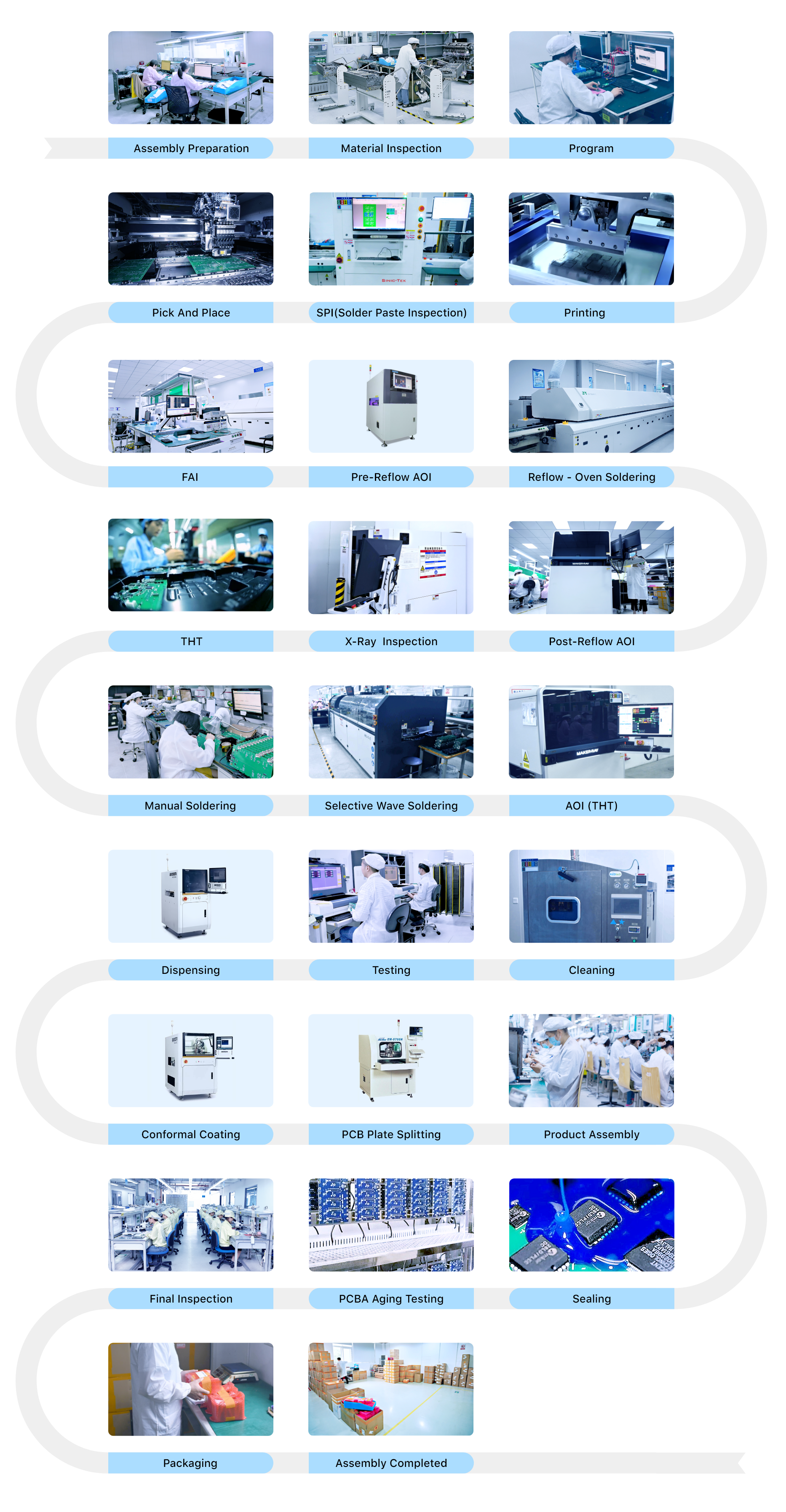PCBA Process at PCBX Workshop
PCB assembly is the backbone of electronic devices, from small consumer electronics to complex industrial machinery. By integrating various electronic components onto a compact circuit board, PCBA enables the miniaturization and integration of electronic systems, making it an essential component of modern electronic products.

Step 1 Assembly Preparation
During the preparation stage, pcbx staff will carefully check the user's production files to ensure that everything is correct before starting the next production work.
Step 2 Material Inspection
The pcbx assembly workshop will receive the corresponding materials based on the user's BOM.
Step 3 Material Preparation
The staff will load the received materials into the corresponding placement machine.
Step 4 PROGRAM
Input the pre-written program code into the memory on the PCBA board so that the device can work according to the requirements of the program.
Step 5 Printing
The PCB assembly process starts by applying solder paste onto the board using a stainless-steel stencil. This paste, a mix of solder and flux, is placed precisely where components will be placed with PCBX smt line. It's crucial for accurate and reliable connections. Automated equipment is used to carefully apply the solder paste to designated locations on the PCB with PCBX, ensuring the right amount and placement for proper soldering in the next steps.
Step 6 SPI(Solder Paste Inspection)
A solder paste inspection (SPI) machine measures the height, volume, and area of solder paste deposits. It also computes stencil offsets and identifies defects in printed circuit boards (PCBs). These machines can accurately measure solder paste deposits, which is critical for early detection of defects within the screen printing process of PCB manufacturing.
Step 7 Pick&Place
After the solder paste is applied, a robotic pick and place machine positions surface mount components (SMDs) onto the paste. This automated process ensures precise placement and alignment, improving accuracy and consistency compared to manual methods. The machine picks up each component and positions it accurately, reducing human error and enhancing efficiency. This automation results in higher-quality PCB assemblies.
Step 8 FAI (First Article Inspection)
Conducting a rigorous first article inspection is essential to validate the PCBA assembly process and confirm the initial units meet all requirements. This quality control step helps mitigate risks and ensures the final product adheres to the customer's specifications.
Step 9 Pre-Reflow AOI
Manufacturers can rapidly identify and resolve any defects before proceeding to the next phase of PCBA production. This strategic positioning is essential for ensuring a reliable, efficient assembly process.
Step 10 Reflow -Oven Soldering
After component placement, the PCB goes through reflow soldering. In a reflow oven, the assembly is heated, melting the solder and creating reliable connections. Temperature control is crucial for proper soldering and strong joints. The reflow process ensures robust electrical connections and minimizes defects or soldering problems.
Step 11 Post-reflow AOI
"Post-reflow AOI" is usually the last step in SMT circuit board assembly to ensure quality. Some PCBAs will also have ICT, FVT and other testing processes , in order to increase the test coverage rate of PCBAs to 100%.
Step 12 X-Ray Inspection
PCB X-ray inspection is a critical tool that gives manufacturers enhanced visibility into the internal structure and components of their circuit boards. This inspection technique helps ensure high-quality, reliable PCB assemblies by detecting a range of potential defects.
Step 13 THT
Some PCB designs have through-hole components that need to be inserted. These components have leads that go through plated holes in the PCB for extra connectivity. Two methods are used: manual soldering and wave soldering. Manual soldering requires careful placement and soldering by hand. Wave soldering is automated, with the PCB passing through molten solder, which solders the components from below. Paying attention to detail and following soldering standards is important for good solder flow and strong connections.
Step 14 Manual Soldering
Manual soldering is an essential skill for electronics manufacturing, installation, maintenance, and repair. It allows technicians to make customized connections and perform delicate soldering work to assemble, rework, or fix electronic products and circuits..At pcbx pcba factory, our technicians are skilled with more than 10 years manual soldering experience.
Step 15 Selective Wave Soldering
Selective wave soldering is a hybrid soldering technique that combines elements of traditional wave soldering and fountain soldering. This method allows manufacturers to assemble circuit boards with through-hole components without the need for manual hand soldering.By blending the strengths of wave and fountain soldering, selective wave soldering gives manufacturers a flexible, high-quality soldering approach. This hybrid technique allows for the assembly of mixed-technology circuit boards without the need for laborious hand soldering.
Step 16 AOI (THT)
THT assemblies must be inspected in regards to
appropriate mounting and soldering. For executing tests in various production process steps the
usage of a stand-alone AOI system with manual loading provides a particularly high flexibility.
Step 17 Cleaning
One solution to future problems is to thoroughly clean the PCBA surface after fitting components from flux residues, chemicals and other potentially harmful substances. Thorough use of cleaning agents on the surface consequently affects other process steps such as conformal coating. Poorly cleaned or uncleaned PCBAs can subsequently cause module failure in the final product.
Step 18 Testing
After completing the cleaning of the board, pcbx PCBA factory staff will conduct a preliminary comprehensive inspection of the board.
Step 19 Dispensing
The mixed placement process, where through-hole insertion (THT) and surface mount (SMT) components coexist, primarily utilizes the dispensing process.
Step 20 Conformal Coating
Conformal coating is a specialized polymeric film-forming product used to protect circuit boards, components, and other electronic devices from adverse environmental conditions.
Step 21 PCB Plate Splitting
After the assembly work is completed, the PCB needs to be spliced for subsequent testing, packaging and other work. At pcbx Assembly factory,we choose the splitting machine EM-5700N.
Step 22 Product Assembly
Product assembly includes not only the production of printed circuit boards (PCBs), but also patch/plug-in soldering processing to electromechanical components such as plastics, hardware housing manufacturing, installation and routing of cables or wire harnesses, and installation of sub-assemblies.
Step 23 Accelerated(Aging)
During PCBA production, aging test is necessary. The aging test generally simulates the external humid and high-temperature environment to test the PCBA finished product, so that the functional board is subjected to the change of air temperature or other factors.
Step 24 Sealing
PCBA sealing, is a technique used to protect printed circuit board assemblies (PCBAs) from environmental factors and physical damage. The process involves encapsulating the PCBA and its housing in a thick layer of resin. This resin coating serves as a barrier, shielding the sensitive electronic components from various environmental stresses, such as moisture, chemicals, vibration, and impact. Potting helps to maintain the integrity and reliability of the PCBA by preventing external elements from reaching and potentially compromising the delicate circuitry. This method is commonly employed in applications where the PCBA will be exposed to harsh or demanding environments, ensuring the long-term functionality and performance of the electronic device.
Step 25 Final Checking
In the final stage of the finished product, pcbx's testing team will conduct comprehensive tests on the performance and functions of the assembled boards. After passing various tests, they will be handed over to the warehouse for packaging and shipment. If there are any problems, we will communicate with factory technicians and users.
Step 26 Packaging
In the pcbx warehouse, we will strictly package the assembled boards to ensure that during transportation, the boards can be delivered to the user intact.
Step 27 Assembly Completed
After packaging is completed, the goods are stored in pcbx's warehouse, waiting for delivery by the logistics company. PCBX's sales will send emails to customers, and customers can check the order progress through the logistics provider's platform.
Conclusion:To stay competitive and meet the evolving demands of the market, it is crucial for PCB manufacturers to remain up-to-date on the latest industry trends and developments. At PCBX, we recognize the significance of this and continuously invest in the most advanced PCB assembly processes and technologies. By staying at the forefront of innovation, we are able to provide our customers with cutting-edge solutions that address their needs and keep them ahead of the curve.



